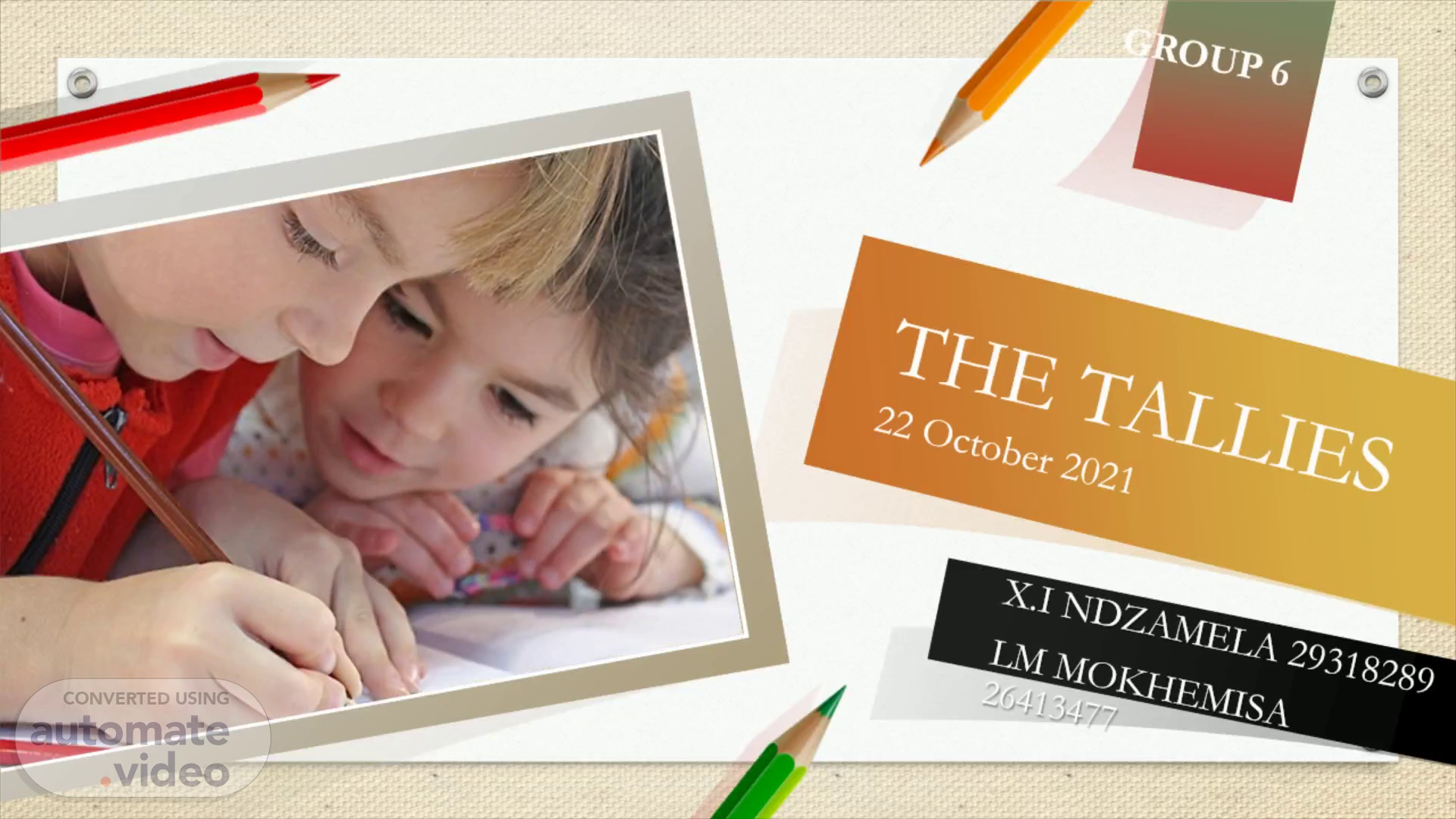
THE TALLIES 22 October 2021
Scene 1 (0s)
X.I NDZAMELA 29318289 LM MOKHEMISA 26413477. Kids on Desk Looking at Notebook.
Scene 2 (10s)
Content Topic:. Permutation and Combination: Probability.
Scene 3 (20s)
Mathematics Grade 6. 3. Topic of the previous week.
Scene 4 (54s)
Topic of the lesson: Probability Duration of the lesson: 30 min Grade: 6 LESSON OBJECTIVES At the end of this lesson, learners must be able to: Perform simple repeated events using three coloured dice. List all possible outcomes in a tally table. Record the actual outcomes in the tally table. Interpret possible outcomes for each specific dice in a specific event in an ordered arrangement..
Scene 5 (1m 35s)
Area- This is a Public primary school at a township in Kroonstad. Number of learners & age- there are 34 learners in the grade 6 class ( 19 girls and 15 boys) and the ages of learners vary from 10 to 14 years. Facilities at school- each classroom has a desk and chair for each learner. The classroom has a blackboard, whiteboard, and a overhead projector. The learners receive hardcopy textbook and DBE workbooks from the Department of Education. Language barrier- The language groups represented in the class are Setwana , Sesotho, Sepedi, and isiXhosa. However, the school’s medium of instruction is English ..
Scene 6 (2m 26s)
MATHEMATICS. 6. Strengths of the lesson. Data handling is an important part of mathematics education since it covers real-world scenarios and helps learners build critical thinking skills. Data handling helps learners in the process of gathering , recording and presenting information in a way that is helpful to others. Collecting, organizing, analyzing, summarizing, and interpreting data, as well as drawing conclusions and making predictions, are all part of making meaning of data. We calculate the number of possible rearrangements of a set of items using permutations. We count the amount of combinations we can 'select' from a wider set of objects when we use combinations. Permutations and combinations are important statistical concepts..
Scene 7 (3m 30s)
Mathematics Grade 6. 7. Weaknesses of the lesson/Misconceptions.
Scene 8 (4m 1s)
CAPS Document. Mathematics Grade 6. 8. (huts) DATAHAIOII\G II Ptobilit! spill}" nspnwwsn21traIsIfI"iNnpghe8JIBfnl.
Scene 9 (4m 13s)
Mathematics Grade 6. 9. Links to specific teaching-learning.
Scene 10 (5m 20s)
Introduction. Exploring Probability. Games to Play with <strong>Dice</strong> - In The Playroom.
Scene 11 (5m 29s)
Introduction. Back to the basics: Vocabulary Probability - A chance of an event happening Outcome - A possible result of a trial Event- A set of Outcomes from an experiment or trial. Lets play a game Play this game in a team of 4 players. You need 3 dice and 20 counters. Take turns to throw the dice. Add, subtract, multiply or divide the numbers on the three dice. Cover the numbers (your solutions) on the grip. The team that covers all or most of the numbers on the grip in the winner..
Scene 12 (6m 59s)
Teaching and learning phase. Look at the dice: A dice has six sides. This means that there can be six outcomes when throwing a dice. You can either throw a one, two, three, four, five, or six for each event or trial. Example: You have three trials to roll the dice, for each trial of event: What are the chances of rolling a 6 in each die for each event? What are the chances of rolling a 3 in each die for each event? What are the chances of rolling a 1 in each die? Answer The chances of rolling a 6 in each die in the first trial = 1/ 6 P (Event)= 1/6 The chances of rolling a 3 in each die= 1:6 P(Event)= 1:6 The chance of rolling a 1 in each die= 1:6.
Scene 13 (8m 58s)
Mathematics Grade 6. 13. Teaching and learning phase.
Scene 14 (9m 14s)
Mathematics Grade 6. 14. Teaching and learning phase.
Scene 15 (10m 17s)
15. Conclusion. Record your overall frequency in the table below and compare your results with other groups. Are the results the same? Write two sentences to describe your results.
Scene 16 (10m 41s)
ADD A FOOTER. 16. Reflection. Checklist Reflection Document.
Scene 17 (11m 12s)
Mathematics Grade 6. 17. The End of the lesson. Thank you!.